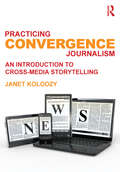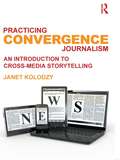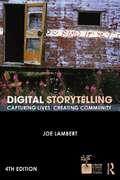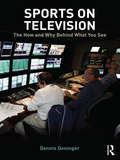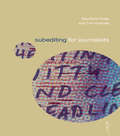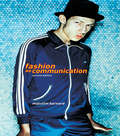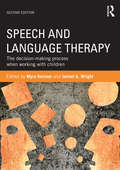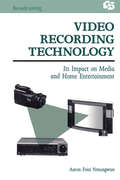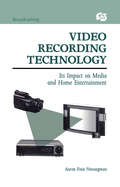- Table View
- List View
Exploring Professional Communication: Language in Action
by Stephanie SchnurrRoutledge Introductions to Applied Linguistics is a series of introductory level textbooks covering the core topics in Applied Linguistics, primarily designed for those beginning postgraduate studies, or taking an introductory MA course as well as advanced undergraduates. Titles in the series are also ideal for language professionals returning to academic study. The books take an innovative ‘practice-to-theory’ approach, with a 'back-to-front' structure. This leads the reader from real-world problems and issues, through a discussion of intervention and how to engage with these concerns, before finally relating these practical issues to theoretical foundations. Additional features include tasks with commentaries, a glossary of key terms, and an annotated further reading section. Exploring Professional Communication provides an accessible overview of the vast field of communication in professional contexts from an applied linguistics perspective. It explores the nature of professional communication by discussing various fundamental topics relevant for an understanding of this area. The book is divided into eight chapters, each dealing with a specific area of professional communication, such as genres of professional communication, identities in the workplace, and key issues of gender, leadership and culture. Although the book’s main approach to professional communication is an applied linguistics one, it also draws on insights from a range of other disciplines. Throughout, Stephanie Schnurr takes an interactive approach that is reflected in the numerous examples of authentic discourse data, from a variety of written and spoken contexts. Exploring Professional Communication is critical reading for postgraduate and upper undergraduate students of applied linguistics and communication studies.
Exploring Health Communication: Language in Action
by Kevin Harvey Nelya KoteykoRoutledge Introductions to Applied Linguistics is a series of introductory level textbooks covering the core topics in Applied Linguistics, primarily designed for those beginning postgraduate studies, or taking an introductory MA course as well as advanced undergraduates. Titles in the series are also ideal for language professionals returning to academic study. The books take an innovative ‘practice to theory’ approach, with a 'back-to-front' structure. This leads the reader from real-world problems and issues, through a discussion of intervention and how to engage with these concerns, before finally relating these practical issues to theoretical foundations. Additional features include tasks with commentaries, a glossary of key terms, and an annotated further reading section. Exploring Health Communication brings together many of the various linguistic strands in health communication, while maintaining an interdisciplinary focus on method and theory. It critically explores and discusses a number of underlying themes that constitute the broad field of health communication including spoken, written and electronic health communication. The rise of the internet has led to an explosion of interactive online health resources which have profoundly affected the way in which healthcare is delivered, and with this, have brought about changes in the relationship between provider and patient. This textbook uses examples of real life health language data throughout, in order to fully explore the topics covered. Exploring Health Communication is essential reading for postgraduate and upper undergraduate students of applied linguistics and health communication.
Exploring Health Communication: Language in Action
by Kevin Harvey Nelya KoteykoRoutledge Introductions to Applied Linguistics is a series of introductory level textbooks covering the core topics in Applied Linguistics, primarily designed for those beginning postgraduate studies, or taking an introductory MA course as well as advanced undergraduates. Titles in the series are also ideal for language professionals returning to academic study. The books take an innovative ‘practice to theory’ approach, with a 'back-to-front' structure. This leads the reader from real-world problems and issues, through a discussion of intervention and how to engage with these concerns, before finally relating these practical issues to theoretical foundations. Additional features include tasks with commentaries, a glossary of key terms, and an annotated further reading section. Exploring Health Communication brings together many of the various linguistic strands in health communication, while maintaining an interdisciplinary focus on method and theory. It critically explores and discusses a number of underlying themes that constitute the broad field of health communication including spoken, written and electronic health communication. The rise of the internet has led to an explosion of interactive online health resources which have profoundly affected the way in which healthcare is delivered, and with this, have brought about changes in the relationship between provider and patient. This textbook uses examples of real life health language data throughout, in order to fully explore the topics covered. Exploring Health Communication is essential reading for postgraduate and upper undergraduate students of applied linguistics and health communication.
Practicing Convergence Journalism: An Introduction to Cross-Media Storytelling
by Janet KolodzyPracticing Convergence Journalism teaches budding journalists how to make the most of digital technology to tell their stories effectively across multiple media platforms—in print, audio, video and online. Janet Kolodzy addresses multi-media and cross-media thinking, organizing, reporting and producing for both short-form spot news and long-form features. Her approach focuses on storytelling principles, not just specific technical practices, providing journalists with the mindset and skills they need to adapt their writing and reporting for the tools of today and tomorrow. With this book and the aid of its companion website, students learn how to: Develop a cross-media mode of journalistic thinking that will result in stories suitable for a fast-paced, multitasking and mobile audience. Decide when visuals are useful and necessary, and understand how to capture, select and organize them to effectively enhance a reader’s understanding of a story. Put together various elements of storytelling (writing, audio, moving and still pictures) for an interactive journalistic experience.
Practicing Convergence Journalism: An Introduction to Cross-Media Storytelling
by Janet KolodzyPracticing Convergence Journalism teaches budding journalists how to make the most of digital technology to tell their stories effectively across multiple media platforms—in print, audio, video and online. Janet Kolodzy addresses multi-media and cross-media thinking, organizing, reporting and producing for both short-form spot news and long-form features. Her approach focuses on storytelling principles, not just specific technical practices, providing journalists with the mindset and skills they need to adapt their writing and reporting for the tools of today and tomorrow. With this book and the aid of its companion website, students learn how to: Develop a cross-media mode of journalistic thinking that will result in stories suitable for a fast-paced, multitasking and mobile audience. Decide when visuals are useful and necessary, and understand how to capture, select and organize them to effectively enhance a reader’s understanding of a story. Put together various elements of storytelling (writing, audio, moving and still pictures) for an interactive journalistic experience.
Digital Storytelling: Capturing Lives, Creating Community
by Joe LambertListen deeply. Tell stories. This is the mantra of the Center for Digital Storytelling (CDS) in Berkeley California, which, since 1998 has worked with nearly 1,000 organizations around the world and trained more than 15,000 people in the art of digital storytelling. In this revised and updated edition of the CDS's popular guide to digital storytelling, co-founder Joe Lambert details the history and methods of digital storytelling practices. Using a "7 Steps" approach, Lambert helps storytellers identify the fundamentals of dynamic digital storytelling--from seeing the story, assembling it, and sharing it. As in the last edition, readers of the fourth edition will also find new explorations of the applications of digital storytelling and updated appendices that provide resources for budding digital storytellers, including information about past and present CDS-affiliated projects and place-based storytelling, a narrative-based approach to understanding experience and landscape. A companion website further brings the entire storytelling process to life. Over the years, the CDS's work has transformed the way that community activists, educators, health and human services agencies, business professionals, and artists think about story, media, culture, and the power of personal voice in creating change. For those who yearn to tell multimedia stories, Digital Storytelling is the place to begin.
Digital Storytelling: Capturing Lives, Creating Community
by Joe LambertListen deeply. Tell stories. This is the mantra of the Center for Digital Storytelling (CDS) in Berkeley California, which, since 1998 has worked with nearly 1,000 organizations around the world and trained more than 15,000 people in the art of digital storytelling. In this revised and updated edition of the CDS's popular guide to digital storytelling, co-founder Joe Lambert details the history and methods of digital storytelling practices. Using a "7 Steps" approach, Lambert helps storytellers identify the fundamentals of dynamic digital storytelling--from seeing the story, assembling it, and sharing it. As in the last edition, readers of the fourth edition will also find new explorations of the applications of digital storytelling and updated appendices that provide resources for budding digital storytellers, including information about past and present CDS-affiliated projects and place-based storytelling, a narrative-based approach to understanding experience and landscape. A companion website further brings the entire storytelling process to life. Over the years, the CDS's work has transformed the way that community activists, educators, health and human services agencies, business professionals, and artists think about story, media, culture, and the power of personal voice in creating change. For those who yearn to tell multimedia stories, Digital Storytelling is the place to begin.
Sports on Television: The How and Why Behind What You See
by Dennis DeningerIn Sports on Television, Dennis Deninger provides an all-encompassing view of the sports television industry. He progresses from the need for this book, to the history of the industry and discipline, to the pioneering events of sports broadcasting and sports television, to a nuts-and bolts, behind-the-scenes look at a sports television production. All the while, he examines the impact that sports and the mass media have had (and are continuing to have) on one another and on society.
Sports on Television: The How and Why Behind What You See
by Dennis DeningerIn Sports on Television, Dennis Deninger provides an all-encompassing view of the sports television industry. He progresses from the need for this book, to the history of the industry and discipline, to the pioneering events of sports broadcasting and sports television, to a nuts-and bolts, behind-the-scenes look at a sports television production. All the while, he examines the impact that sports and the mass media have had (and are continuing to have) on one another and on society.
A Cognitive Psychology of Mass Communication
by Richard Jackson Harris Fred W. SanbornA Cognitive Psychology of Mass Communication is the go-to text for any course that adopts a cognitive and psychological approach to the study of mass communication. In its sixth edition, it continues its examination of how our experiences with media affect the way we acquire knowledge about the world, and how this knowledge influences our attitudes and behavior. Using theories from psychology and communication along with reviews of the most up-to-date research, this text covers a diversity of media and media issues ranging from commonly discussed topics, such as politics, sex, and violence, to lesser-studied topics, such as sports, music, emotion, and prosocial media. This sixth edition offers chapter outlines and recommended readings lists to further assist readability and accessibility of concepts, and a new companion website that includes recommended readings, even more real-world examples and activities, PowerPoint presentations, sample syllabi, and an instructor guide.
A Cognitive Psychology of Mass Communication
by Richard Jackson Harris Fred W. SanbornA Cognitive Psychology of Mass Communication is the go-to text for any course that adopts a cognitive and psychological approach to the study of mass communication. In its sixth edition, it continues its examination of how our experiences with media affect the way we acquire knowledge about the world, and how this knowledge influences our attitudes and behavior. Using theories from psychology and communication along with reviews of the most up-to-date research, this text covers a diversity of media and media issues ranging from commonly discussed topics, such as politics, sex, and violence, to lesser-studied topics, such as sports, music, emotion, and prosocial media. This sixth edition offers chapter outlines and recommended readings lists to further assist readability and accessibility of concepts, and a new companion website that includes recommended readings, even more real-world examples and activities, PowerPoint presentations, sample syllabi, and an instructor guide.
Media, Telecommunications, and Business Strategy
by Richard A. GershonWith today’s dynamic and rapidly evolving environment, media managers must have a clear understanding of different delivery platforms, as well as a grasp of critical management, planning, and economic factors in order to stay current and move their organizations forward. Developed for students in telecommunications management, media management, and the business of media, this text helps future media professionals understand the relationship and convergence patterns between the broadcast, cable television, telephony, and Internet communication industries. The second edition includes updated research throughout , including material on major business and technology changes and the importance of digital lifestyle reflected in e-commerce and personalized media selection, such as Netflix and iTunes, and the growing importance of Facebook and social networking from a business perspective.
Media, Telecommunications, and Business Strategy
by Richard A. GershonWith today’s dynamic and rapidly evolving environment, media managers must have a clear understanding of different delivery platforms, as well as a grasp of critical management, planning, and economic factors in order to stay current and move their organizations forward. Developed for students in telecommunications management, media management, and the business of media, this text helps future media professionals understand the relationship and convergence patterns between the broadcast, cable television, telephony, and Internet communication industries. The second edition includes updated research throughout , including material on major business and technology changes and the importance of digital lifestyle reflected in e-commerce and personalized media selection, such as Netflix and iTunes, and the growing importance of Facebook and social networking from a business perspective.
Relationship Marketing
by Helen Peck Martin Christopher Moira Clark Adrian PayneArranged in 6 sections, this title gives marketing practitioners and students critical examples of best practice from a variety of companies. Alongside 'Relationship Marketing: bringing quality, customer service and marketing together' and 'Relationship Marketing for Competitive Advantage: winning and keeping customers' this new title provides readers with insights into marketing in the 21st century.
Relationship Marketing
by Helen Peck Martin Christopher Moira Clark Adrian PayneArranged in 6 sections, this title gives marketing practitioners and students critical examples of best practice from a variety of companies. Alongside 'Relationship Marketing: bringing quality, customer service and marketing together' and 'Relationship Marketing for Competitive Advantage: winning and keeping customers' this new title provides readers with insights into marketing in the 21st century.
Subediting and Production for Journalists: Print, Digital & Social
by Wynford Hicks Tim HolmesSubediting for Journalists is a concise, up-to-date and readable introduction to the skills of subediting for newspapers and magazines. It describes how subediting has developed, from the early days of printing to the modern era of computers and the web, and explains clearly what the sub now has to do.Using practical examples from newspapers and magazines, Subediting for Journalists introduces the various techniques involved in subediting from cutting copy to writing cover lines. It includes:*house style explained with model stylebook provided*examples of bad journalistic English such as misused clichés and pronoun confusion*subbing news and features for sense and style*editing quotes and readers' letters*projecting copy by writing headlines and standfirsts*checking pictures and writing captions*principles and methods of proofreading*making copy legally safe*understanding production and using software packages *website subbing*a glossary of journalistic terms and suggestions for further reading
Subediting and Production for Journalists: Print, Digital & Social
by Wynford Hicks Tim HolmesSubediting for Journalists is a concise, up-to-date and readable introduction to the skills of subediting for newspapers and magazines. It describes how subediting has developed, from the early days of printing to the modern era of computers and the web, and explains clearly what the sub now has to do.Using practical examples from newspapers and magazines, Subediting for Journalists introduces the various techniques involved in subediting from cutting copy to writing cover lines. It includes:*house style explained with model stylebook provided*examples of bad journalistic English such as misused clichés and pronoun confusion*subbing news and features for sense and style*editing quotes and readers' letters*projecting copy by writing headlines and standfirsts*checking pictures and writing captions*principles and methods of proofreading*making copy legally safe*understanding production and using software packages *website subbing*a glossary of journalistic terms and suggestions for further reading
Fashion as Communication
by Malcolm BarnardWhat kinds of things do fashion and clothing say about us? What does it mean to wear Gap or Gaultier, Milletts or Moschino? Are there any real differences between Hip-Hop style and Punk anti-styles? In this fully revised and updated edition, Malcolm Barnard introduces fashion and clothing as ways of communicating and challenging class, gender, sexual and social identities.Drawing on a range of theoretical approaches from Barthes and Baudrillard to Marxist, psychoanalytic and feminist theory, Barnard addresses the ambivalent status of fashion in contemporary culture.
Fashion as Communication
by Malcolm BarnardWhat kinds of things do fashion and clothing say about us? What does it mean to wear Gap or Gaultier, Milletts or Moschino? Are there any real differences between Hip-Hop style and Punk anti-styles? In this fully revised and updated edition, Malcolm Barnard introduces fashion and clothing as ways of communicating and challenging class, gender, sexual and social identities.Drawing on a range of theoretical approaches from Barthes and Baudrillard to Marxist, psychoanalytic and feminist theory, Barnard addresses the ambivalent status of fashion in contemporary culture.
Speech and Language Therapy: The decision-making process when working with children
by Myra Kersner Jannet A. WrightNow in its second edition, Speech and Language Therapy: the decision-making process when working with children reveals how recent research and changes in health and education services have affected the decision-making process in the assessment and management of children with speech and language problems. With individual chapters written by experts in their field, this book: Illustrates how the decisions made by practitioners may vary within different work settings Shows how these decisions may need to be adapted when working with specific client groups Explores how such decisions are part of effective evidence-based practice Offers an overview of the skills required by the developing professional Provides insight into working as a newly qualified therapist in the current job market. Rigorously underpinned with current research and revised legislation, this is an important textbook for speech and language therapy students, potential students and specialist teachers in training. Speech and Language Therapy: the decision-making process when working with children will also be relevant to newly qualified therapists, therapists returning to the profession, specialist teachers and Special Educational Needs Coordinators.
Communication Research Methodology: A Strategic Approach to Applied Research
by Gary Pettey Cheryl Campanella Bracken Elizabeth B. PaskThis introduction to communication research methods takes the student from the conceptual beginnings of a research project through the design and analysis. Emphasizing the correct questions to ask and how to approach the answers, authors Gary Petty, Cheryl Campanella Bracken, and Elizabeth Babin approach social science methods as a language to be learned, requiring multiple sessions and reinforcement through practice. They explain the basics of conducting communication research, facilitating students’ understanding of the operation and roles of research so that they can better critique and consume the materials in their classes and in the media. The book takes an applied methods approach, introducing students to the conceptual elements of communication science and then presenting these elements in a single study throughout the text, articulating the similarities and differences of individual methods along the way. The study is presented as a communication campaign, involving multiple methodologies. The approach highlights how one method can build upon another and emphasizes the fact that, given the nature of methodology, no single study can give complete answers to our research questions. Unique features of the text: It introduces students to research methods through a conceptual approach, and the authors demonstrate that the statistics are a tool of the concepts. It employs an accessible approach and casual voice to personalize the experience for the readers, leading them through the various stages and steps. The presentation of a communication campaign demonstrates each method discussed in the text. This campaign includes goals and objectives that will accompany the chapters, demonstrates each individual methodology, and includes research questions related to the communication campaign. The tools gained herein will enable students to review, use, understand, and critique research, including the various aspects of appropriateness, sophistication and utility of research they encounter.
Communication Research Methodology: A Strategic Approach to Applied Research
by Gary Pettey Cheryl Campanella Bracken Elizabeth B. PaskThis introduction to communication research methods takes the student from the conceptual beginnings of a research project through the design and analysis. Emphasizing the correct questions to ask and how to approach the answers, authors Gary Petty, Cheryl Campanella Bracken, and Elizabeth Babin approach social science methods as a language to be learned, requiring multiple sessions and reinforcement through practice. They explain the basics of conducting communication research, facilitating students’ understanding of the operation and roles of research so that they can better critique and consume the materials in their classes and in the media. The book takes an applied methods approach, introducing students to the conceptual elements of communication science and then presenting these elements in a single study throughout the text, articulating the similarities and differences of individual methods along the way. The study is presented as a communication campaign, involving multiple methodologies. The approach highlights how one method can build upon another and emphasizes the fact that, given the nature of methodology, no single study can give complete answers to our research questions. Unique features of the text: It introduces students to research methods through a conceptual approach, and the authors demonstrate that the statistics are a tool of the concepts. It employs an accessible approach and casual voice to personalize the experience for the readers, leading them through the various stages and steps. The presentation of a communication campaign demonstrates each method discussed in the text. This campaign includes goals and objectives that will accompany the chapters, demonstrates each individual methodology, and includes research questions related to the communication campaign. The tools gained herein will enable students to review, use, understand, and critique research, including the various aspects of appropriateness, sophistication and utility of research they encounter.
Video Recording Technology: Its Impact on Media and Home Entertainment
by Aaron Foisi NmungwunVideo recording has recently become an important phenomenon. Although the majority of American homes have at least one video recording set, not much is known about video recording's past and about its continual effect on affiliated industries. This text documents the history of magnetic recording, stressing its importance in consumer as well as commercial applications from the advent of magnetism through the invention of such new technologies as Digital Audio Tape (DAT), High Definition Television (HDTV), and a multitude of sophisicated Digital Video Cassette Recorders.
Video Recording Technology: Its Impact on Media and Home Entertainment
by Aaron Foisi NmungwunVideo recording has recently become an important phenomenon. Although the majority of American homes have at least one video recording set, not much is known about video recording's past and about its continual effect on affiliated industries. This text documents the history of magnetic recording, stressing its importance in consumer as well as commercial applications from the advent of magnetism through the invention of such new technologies as Digital Audio Tape (DAT), High Definition Television (HDTV), and a multitude of sophisicated Digital Video Cassette Recorders.
Communication Studies: The Essential Resource
by Andrew Beck Peter Bennett Peter WallThis book brings together a huge range of material including academic articles, film scripts and interplanetary messages adrift on space probes with supporting commentary to clarify their imporatance to the field. Communication Studies: The Essential Resource is a collection of essays and texts for all those studying communication at university and pre-university level. Individual sections address: * texts and meanings in communication* themes in personal communication* communication practice* culture, communication and context* debates and controversies in communication.Edited by the same teachers and examiners who brought us AS Communication Studies: The Essential Introduction, this volume will help communications students to engage with the subject successfully. Its key features include: * suggested further activities at the end of each chapter* a glossary of key terms* a comprehensive bibliography with web resources.



